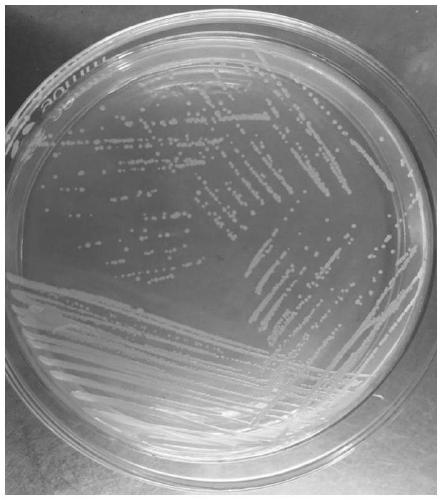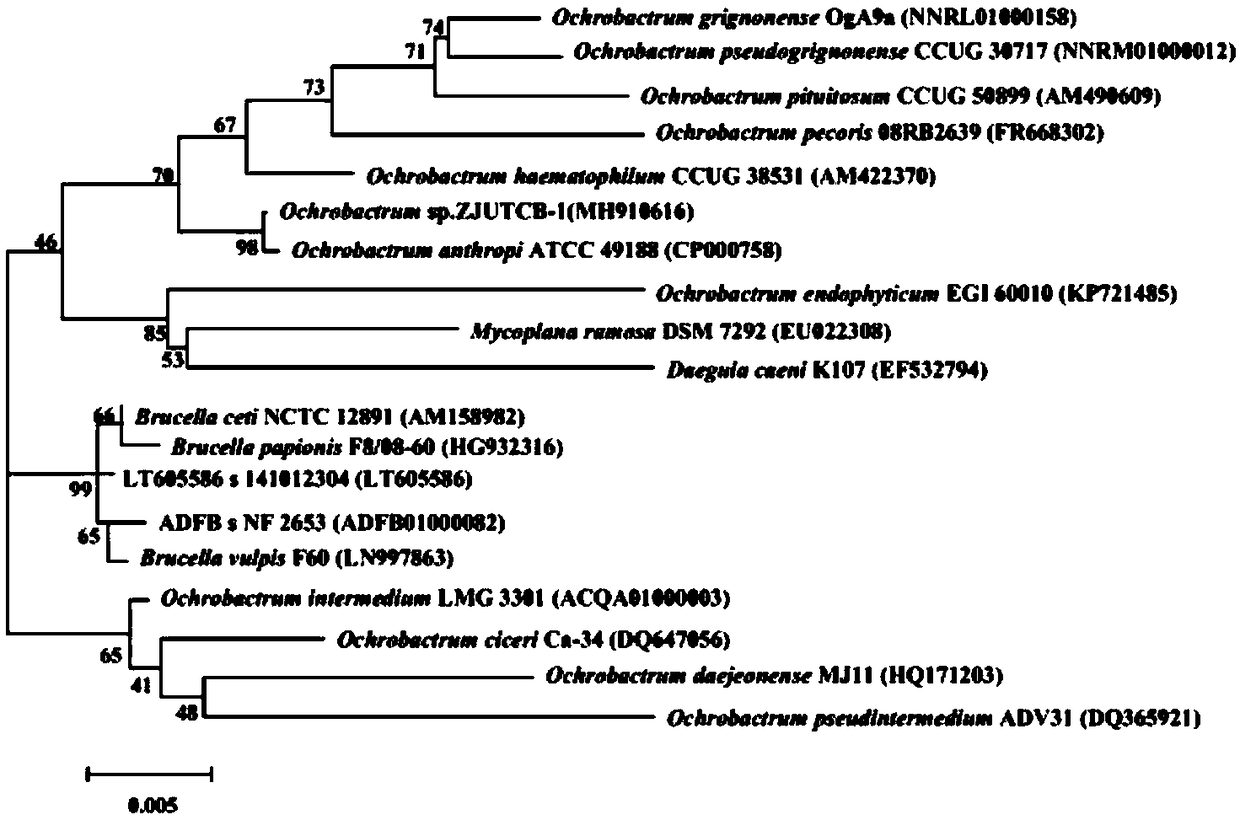Ochrobactrum ZJUTCB-1 capable of efficiently degrading chlorobenzene and application of ochrobactrum ZJUTCB-1
A technology of ZJUTCB-1 and Pallidum, which is applied in the field of biological treatment of environmental pollutants, can solve the problems of maintaining high efficiency, not meeting high-efficiency production, and low degradation rate, and achieve low purification cost, high-efficiency purification, and low pollution.
- Summary
- Abstract
- Description
- Claims
- Application Information
AI Technical Summary
Problems solved by technology
Method used
Image
Examples
Embodiment 1
[0020] Example 1: Separation, purification, identification and preservation of Ochrobacterum sp. ZJUTCB-1.
[0021] 1. Screening of Ochrobacterum sp.ZJUTCB-1
[0022] Ochrobacterum sp.ZJUTCB-1 is a Gram-negative bacterium domesticated and isolated from the activated sludge of Hangzhou Qige Wastewater Treatment Plant. Specific steps are as follows:
[0023]Add 200ml of inorganic salt culture solution to a 340mL serum bottle, pass high-purity nitrogen gas (40mL / min) for 30min to remove the dissolved oxygen in the inorganic salt culture solution and the air at the top of the serum bottle, add 20mL of activated sludge and 987μmol / L Chlorobenzene, at 30°C, 160rpm for enrichment culture. When the concentration of chlorobenzene is 50% of the initial concentration, take out 20mL of the enrichment solution and add it to 200mL of fresh inorganic salt culture solution, then add 987μmol / L chlorobenzene, and cultivate anaerobically at 30°C and 160rpm to the concentration of chlorobenzene...
Embodiment 2
[0035] Example 2: Activation of Ochrobacterum sp.ZJUTCB-1 and degradation of different concentrations of chlorobenzene under aerobic conditions
[0036] Under the conditions of optimal environmental factors (culture solution pH=7, culture temperature 30°C), the degradation performance and bacterial growth of the strain ZJUTCB-1 to the initial concentration of 347.31-2604.80 μmol / L chlorobenzene under aerobic conditions were investigated. . The results show that the strain can completely degrade 347.31-2604.80 μmol / L of chlorobenzene, with an average speed of 82.27-174.85 μmol / (L h). After the chlorobenzene is fully utilized, the quality of the bacteria ZJUTCB-1 also increases significantly. The specific implementation Proceed as follows:
[0037] Prepare inorganic salt culture solution (same as Example 1), adjust the pH to 7 with sodium hydroxide or dilute hydrochloric acid solution, and distribute it in serum bottles with an average volume of 340 mL, 50 mL per bottle.
[00...
Embodiment 3
[0041] Example 3: Activation of Ochrobacterum sp.ZJUTCB-1 and degradation of different concentrations of chlorobenzene under anaerobic conditions
[0042] Under the conditions of optimal environmental factors (culture solution pH=7, culture temperature 30°C), the degradation performance and bacterial growth of the strain ZJUTCB-1 to the initial concentration of 347.31-2604.80 μmol / L chlorobenzene under anaerobic conditions were investigated. . The results showed that the strain could completely degrade 347.31-1736.53 μmol / L chlorobenzene with an average rate of 97.39-210.38 μmol / (L h). When the concentration of chlorobenzene was as high as 2604.80 μmol / L, the strain could also complete 88.24 % removal, the average removal rate was 102.47μmol / (L·h). After the chlorobenzene is fully utilized, the quality of the bacteria ZJUTCB-1 also increases significantly, and the specific implementation steps are as follows:
[0043]The preparation of seed solution is the same as in Example...
PUM
 Login to View More
Login to View More Abstract
Description
Claims
Application Information
 Login to View More
Login to View More - R&D
- Intellectual Property
- Life Sciences
- Materials
- Tech Scout
- Unparalleled Data Quality
- Higher Quality Content
- 60% Fewer Hallucinations
Browse by: Latest US Patents, China's latest patents, Technical Efficacy Thesaurus, Application Domain, Technology Topic, Popular Technical Reports.
© 2025 PatSnap. All rights reserved.Legal|Privacy policy|Modern Slavery Act Transparency Statement|Sitemap|About US| Contact US: help@patsnap.com



